Stormtools Design Elevation (SDE) Maps: Including Impact of Sea Level Rise
Abstract
1. Introduction
2. Approach and Study Area
2.1. The 100-Yr Water Levels Including Effects of SLR
2.2. Waves Including Effects of SLR
2.3. Narragansett Bay
2.4. Southern RI Shoreline (South Coast)
3. Results
3.1. SDE Maps for South Coast, Southern RI Shoreline
3.2. SDE Maps for Narragansett Bay
4. Conclusions
Author Contributions
Funding
Conflicts of Interest
Acronyms
| ADCIRC | ADvanced CIRCulation model |
| ASCE | American Society of Civil Engineers |
| BCP | Blind Control Points |
| BFE | Base Flood Elevation |
| CERI | Coastal Environmental Risk Index |
| CI | Confidence Interval |
| CRMC | RI Coastal Resources Management Council |
| DEM | Digital Elevation Model |
| ESRI | Supplier of Geographic Information System (GIS) software |
| FEMA | Federal Emergency Management Agency |
| FIRM | Flood Insurance Rate Maps |
| FIS | Flood Insurance Study |
| GIS | Geographic Information System |
| HUD | Housing and Urban Development |
| JONSWAP | JOint North Sea WAve Project |
| L | Linear |
| LIDAR | Laser Imaging, Detection, and Ranging |
| LIMWA | limit of moderate wave action |
| MSL | Mean Sea Level |
| NACCS | USACE, North Atlantic Comprehensive Coastal Study |
| NAVD88 | North Atlantic Vertical Datum, 1988 |
| NL | Nonlinear |
| NOAA NOS | National Ocean and Atmospheric Administration- National Ocean Survey |
| OIG | Office of Inspector General |
| OHCD | Office of Housing and Community Development |
| RI GIS | Rhode Island- Geographic Information System |
| SFHA | Special Flood Hazard Area |
| SDE | STORMTOOLS Design Elevation maps |
| SDS | Synthetic Design Storm |
| SLR | Sea Level Rise |
| STWAVE | STeady state spectral WAVE model |
| SWEL | Still water elevation level |
| STORMTOOLS | tools in support of storm analysis |
| SWAN | Simulating WAves Nearshore |
| URI | University of Rhode Island |
| USACE | US Army Corp of Engineers |
| WL | water level |
| XBeach | nearshore wave and geomorphological model |
References
- FEMA. Flood Insurance Study, Washington County, RI, FEMA Flood Insurance Study Number 44009CV001B; FEMA: Washington, DC, USA, 2012.
- ASCE. Minimum Design Loads and Associated Criteria for Buildings and Other Structures, ASCE /SEI 7-16; ASCE: Reston, VA, USA, 2017; ISBN 978-0-7844-7996-4. [Google Scholar]
- Office of Inspector General (OIG). FEMA Needs to Improve Management of Its Mapping Program; Report OIG-17-110; Department of Homeland Security: Washington, DC, USA, 27 September 2017.
- NRC. Mapping the Zone: Improving Flood Map Accuracy; Committee on FEMA Flood Maps; Board on Earth Sciences and Resources/Mapping Science Committee; National Research Council; National Academies Press: Washington, DC, USA, 2009; ISBN 978-0-309-13057-8.
- FEMA Approved Models. Available online: https://www.fema.gov/coastal-numerical-models-meeting-minimum-requirement-national-flood-insurance-program (accessed on 17 January 2017).
- Federal Emergency Management Agency (FEMA). Atlantic Ocean and Gulf of Mexico Coastal Guidelines Update; FEMA: Washington, DC, USA, 2007.
- Spaulding, M.; Grilli, A.; Damon, C.; Fugate, G.; Oakley, B.A.; Isaji, T.; Schambach, L. Application of state of art modeling techniques to predict flooding and waves for an exposed coastal area. J. Mar. Sci. Eng. 2017, 5, 10. [Google Scholar] [CrossRef]
- Spaulding, M.; Grilli, A.; Damon, C.; Fugate, G.; Isaji, T.; Schambach, L. Application of state of art modeling techniques to predict flooding and waves for coastal area with a protected bay. J. Mar. Sci. Eng. 2017, 5, 10. [Google Scholar] [CrossRef]
- Spaulding, M.L.; Isaji, T.; Damon, C.; Fugate, G. Application of STORMTOOLS’s simplified flood inundation model, with and without sea level rise, to RI coastal waters. In Proceedings of the ASCE Solutions to Coastal Disasters Conference, Boston, MA, USA, 9–11 September 2015. [Google Scholar]
- Spaulding, M.L.; Grilli, A.; Damon, C.; Crean, T.; Fugate, G.; Oakley, B.A.; Stempel, P. STORMTOOLS: Coastal Environmental Risk Index (CERI). J. Mar. Sci. Eng. 2016, 4, 54. [Google Scholar] [CrossRef]
- Spaulding, M.L.; Grilli, A.; Damon, C.; Crean, T.; Fugate, G. Developing the RI Coastal Environmental Risk Index (CERI) to Inform State and Local Planning and Decision Making: Application to the Communities along the Southern RI Shoreline; Report Prepared on Behalf of the RI; Coastal Resources Management Council: South Kingstown, RI, USA, 2019.
- Grilli, A.; Spaulding, M.L.; Damon, C.; Becker, A.; Menendez, J.; Stempel, P.; Crean, T.; Fugate, G. Application of the Coastal Environmental Risk Index (CERI) to Barrington, Bristol, and Warren, RI; Report Prepared for RI; Coastal Resources Management Council: South Kingstown, RI, USA, 2018.
- Cialone, M.A.; Massey, T.C.; Anderson, M.E.; Grzegorzewski, A.S.; Jensen, R.E.; Cialone, A.; Mark, D.J.; Pevey, K.C.; Gunkel, B.L.; McAlpin, T.O.; et al. North Atlantic Coast Comprehensive Study (NACCS) Coastal Storm Model Simulations: Waves and Water Levels; MS 39180-6199, Report: ERDC/CHL TR-15-44; Coastal and Hydraulics Laboratory U.S. Army Engineer Research and Development Center: Vicksburg, MS, USA, August 2015. [Google Scholar]
- Zervas, C. Extreme Water Levels of the United States, 1893–2010; NOAA Technical Report NOS CO-OPS 067; NOAA National Ocean Survey: Washington, DC, USA, 2013.
- Torres, M.; Hashemi, R.; Hayward, S.; Spaulding, M.; Ginis, I.; Grilli, S. The role of hurricane wind models in accurate simulations of storm surge and waves. ASCE J. Waterw. Port Coast. Ocean Eng. 2019, 145, 04018039. [Google Scholar] [CrossRef]
- Smith, J.M.; Sherlock, A.R.; Resio, D.T. STWAVE: Steady-State Wave Model User’s Manual for STWAVE, Version 3.0; ERDC/CHL SR-01-01; U.S. Army Engineering Research and Development Center: Vicksburg, MS, USA, 2001. [Google Scholar]
- Massey, T.C.; Anderson, M.E.; McKee-Smith, J.; Gomez, J.; Rusty, J. STWAVE: Steady State Spectral Wave Model. User’s Manual for STWAVE, Version 6.0; US Army Corp of Engineers, Environmental Research and Development Center: Vicksburg, MI, USA, 2011. [Google Scholar]
- Schambach, L.; Grilli, A.; Grilli, S.; Hashemi, R.; King, J.W. Assessing the impact of extreme storms on barrier beaches along the Atlantic coastline: Application to southern Rhode Island coast. Coast. Eng. 2018, 133, 26–42. [Google Scholar] [CrossRef]
- Sallenger, A.H. Storm impact scale for barrier islands. J. Coast. Res. 2000, 16, 890–895, ISSN 0749-0208. [Google Scholar]
- Harter, C.F.; Figlus, J. Numerical modeling of the morphodynamics of low lying barrier island beach and foredune system inundated during Hurricane Ike, using XBeach and CSHORE. Coast. Eng. 2017, 120, 64–74. [Google Scholar] [CrossRef]
- Grilli, A.; Spaulding, M.L.; Oakley, B.A.; Damon, C. Mapping the coastal risk for the next century, including sea level rise and changes in the coastline: Application to Charlestown RI, USA. Nat. Hazards 2017, 88, 389–414. [Google Scholar] [CrossRef]
- Al Naser, N.; Grilli, A.; Grilli, S.; Baxter, C.; Bradshaw, A.; Maggi, B. Land use and mitigation effects on barrier beach erosion in storms: Case study in Rhode Island. Coast. Eng. Proc. 2018, 108. [Google Scholar] [CrossRef][Green Version]
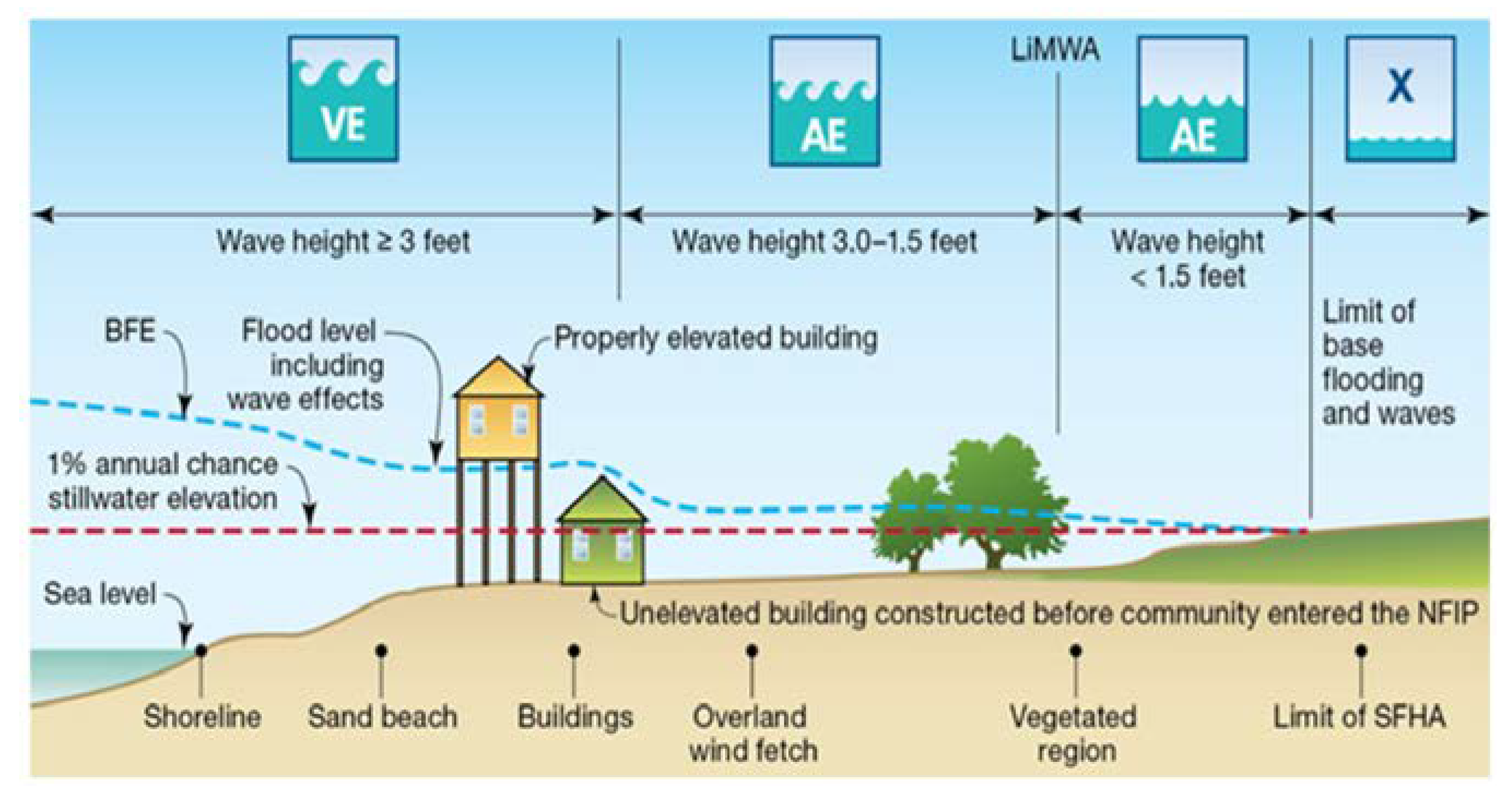
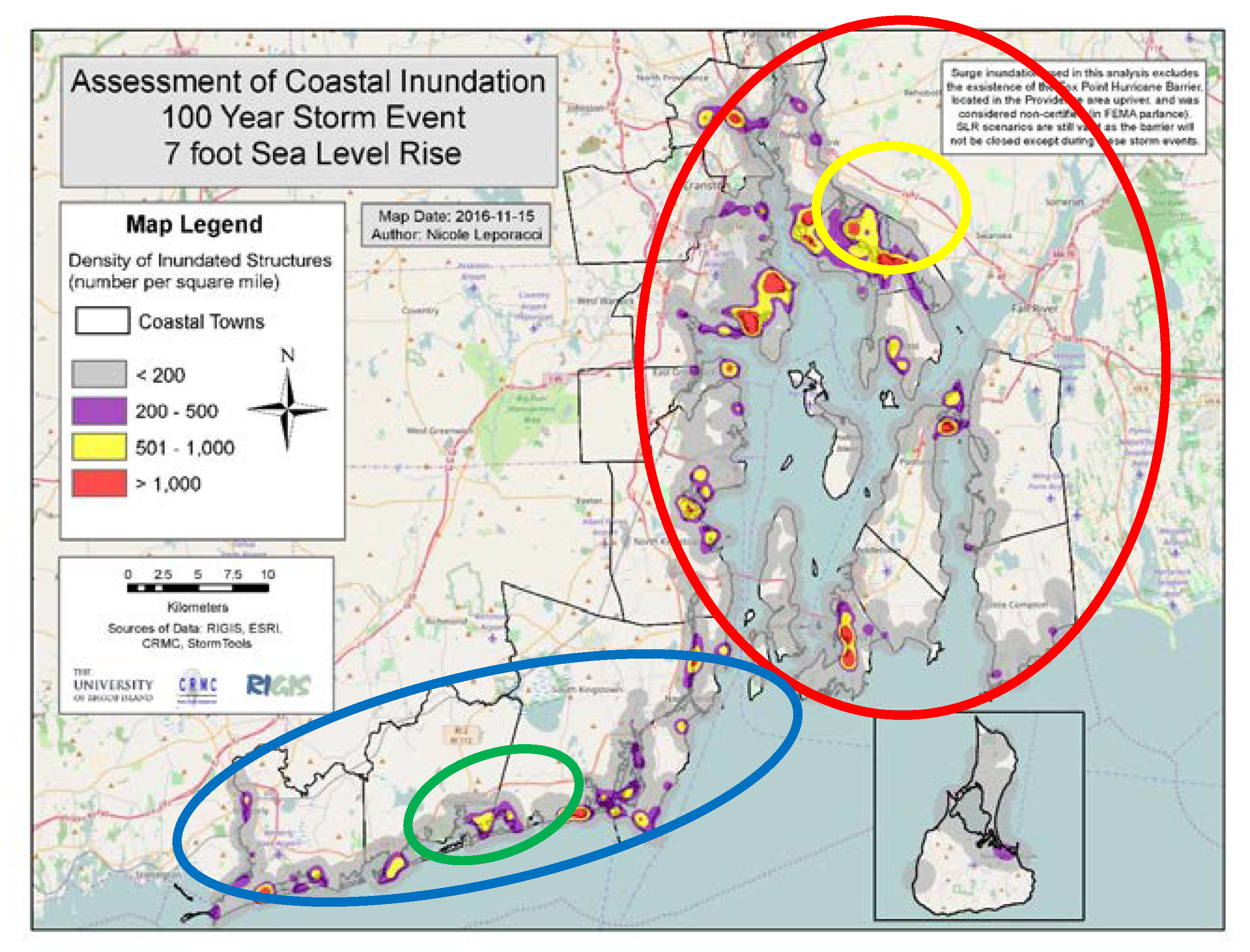
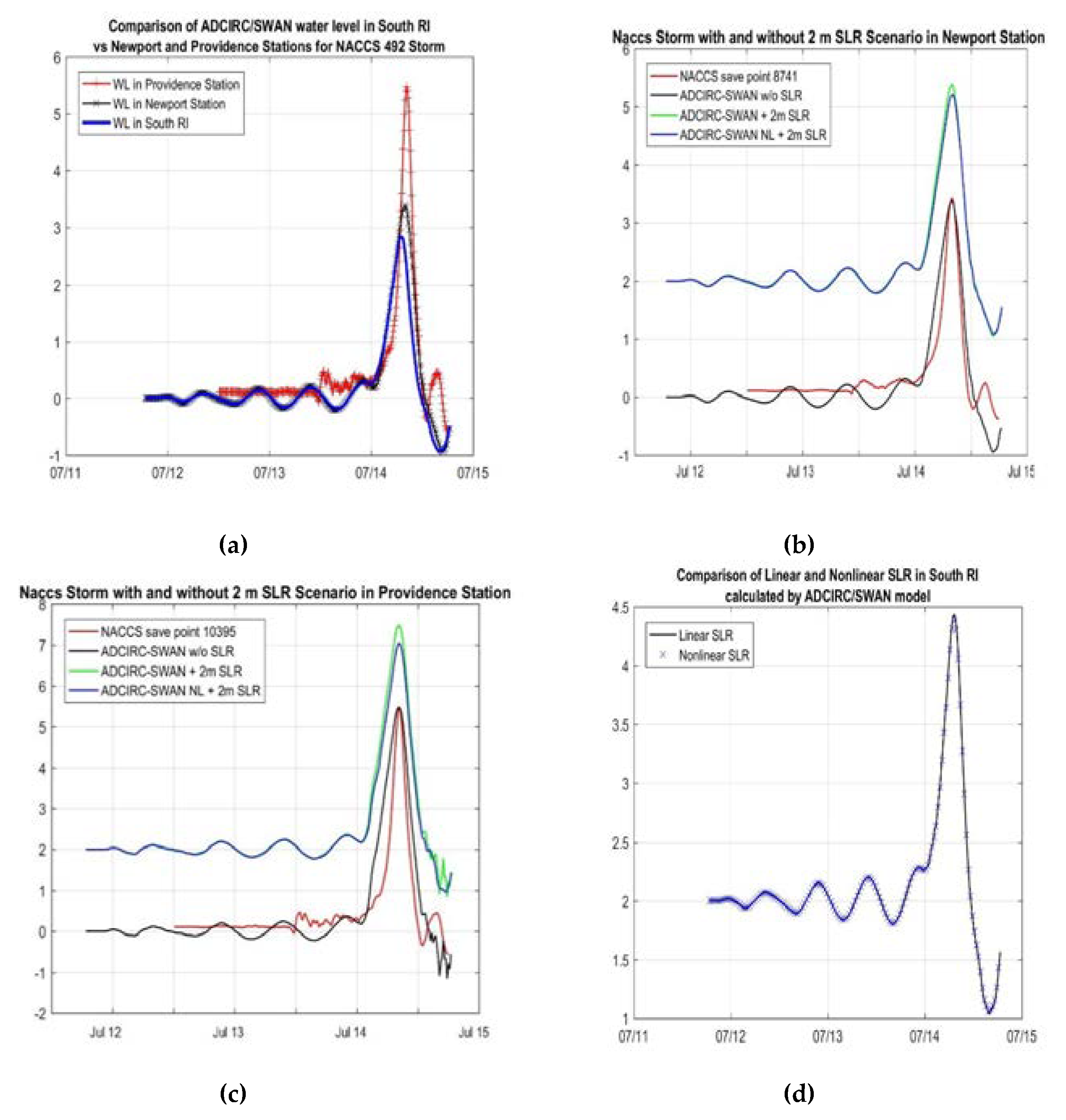
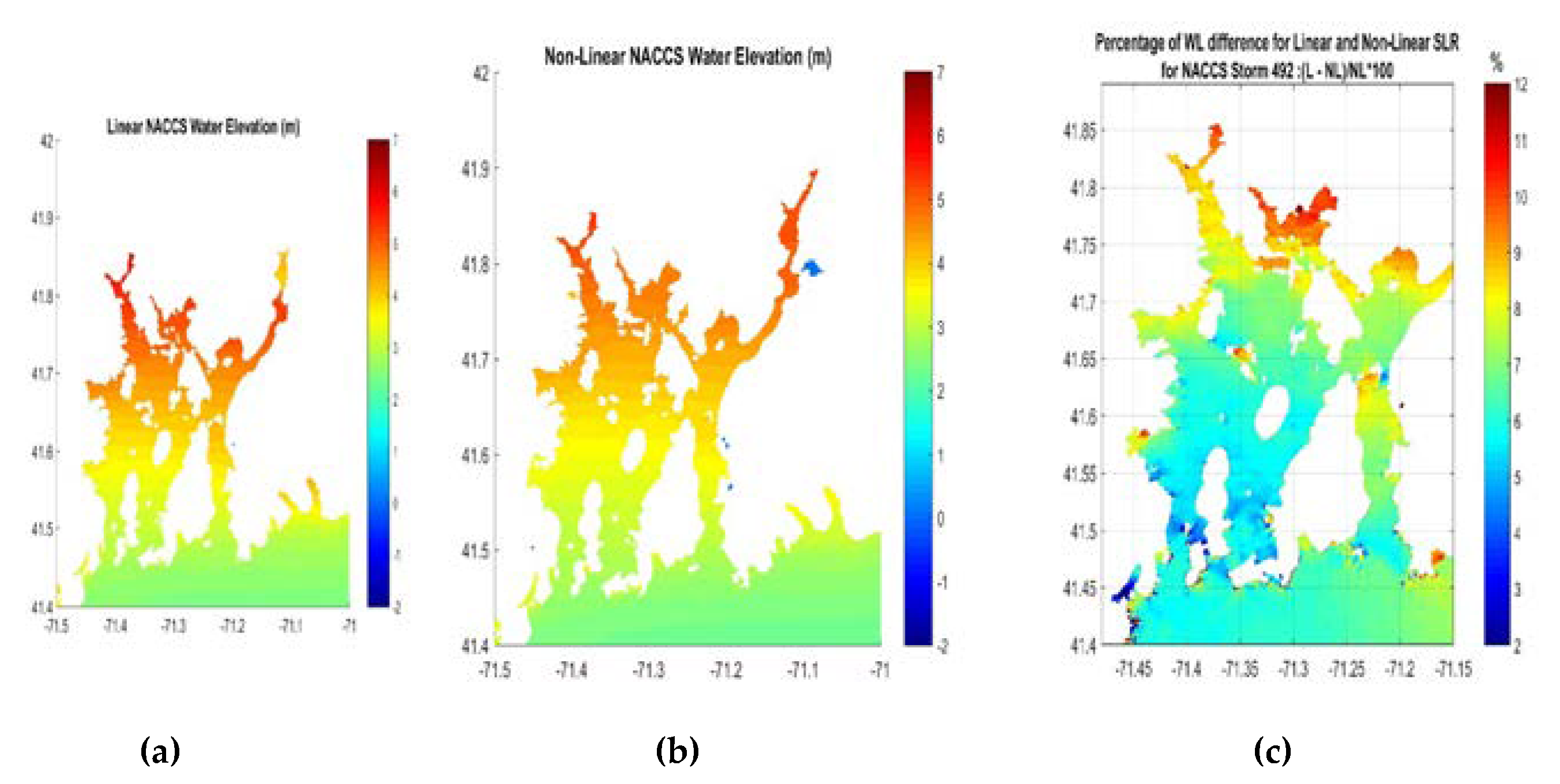
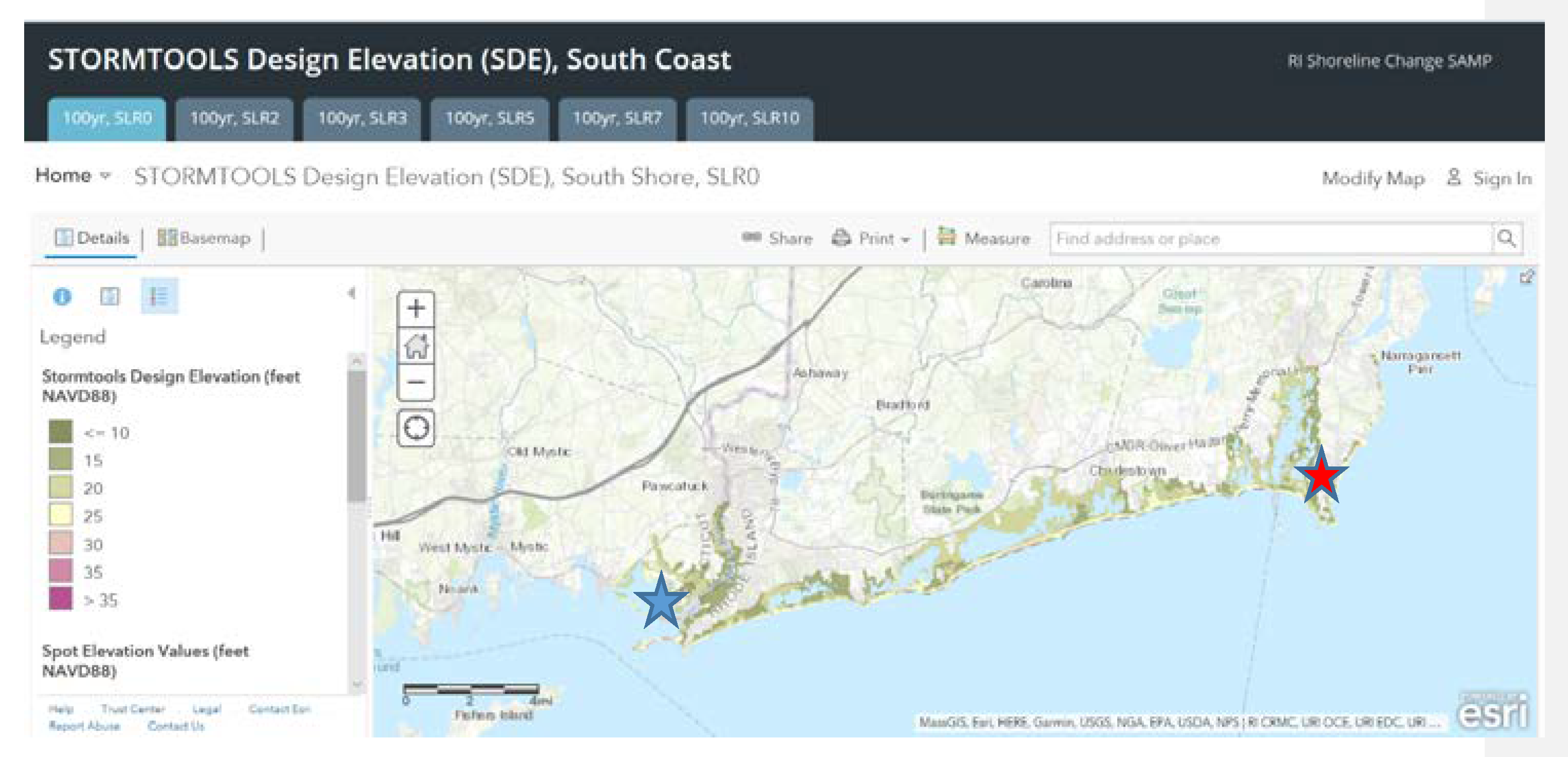
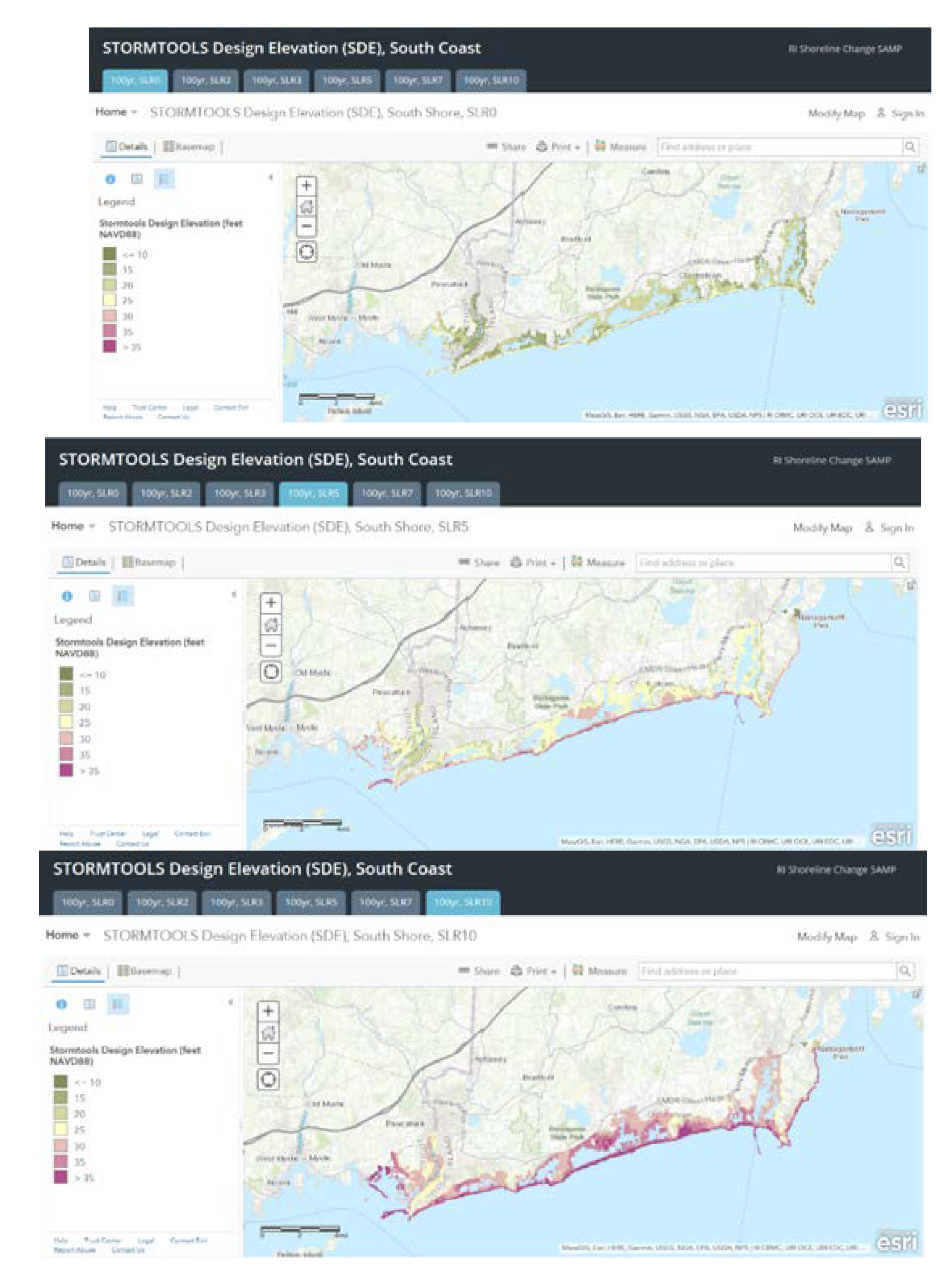
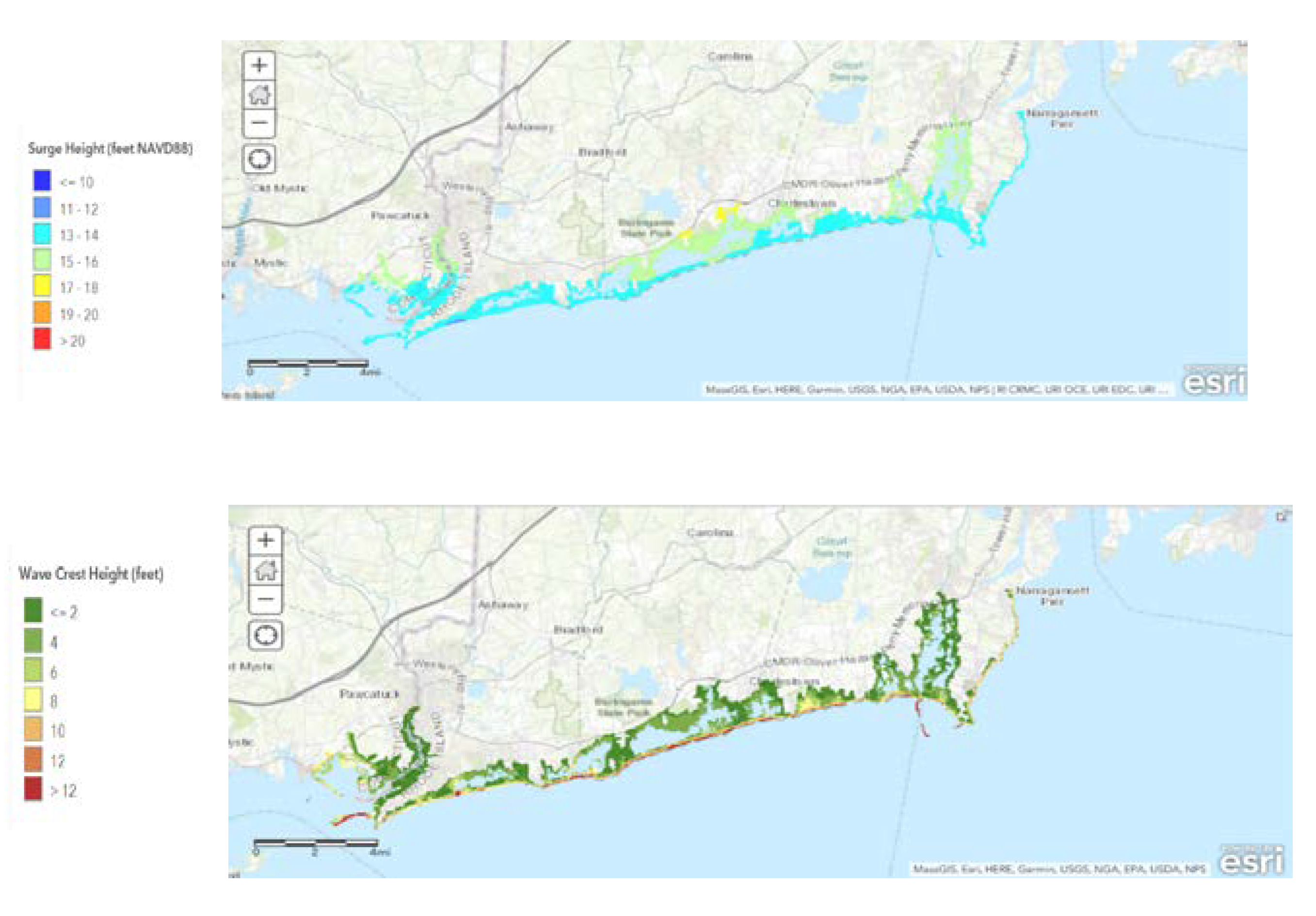
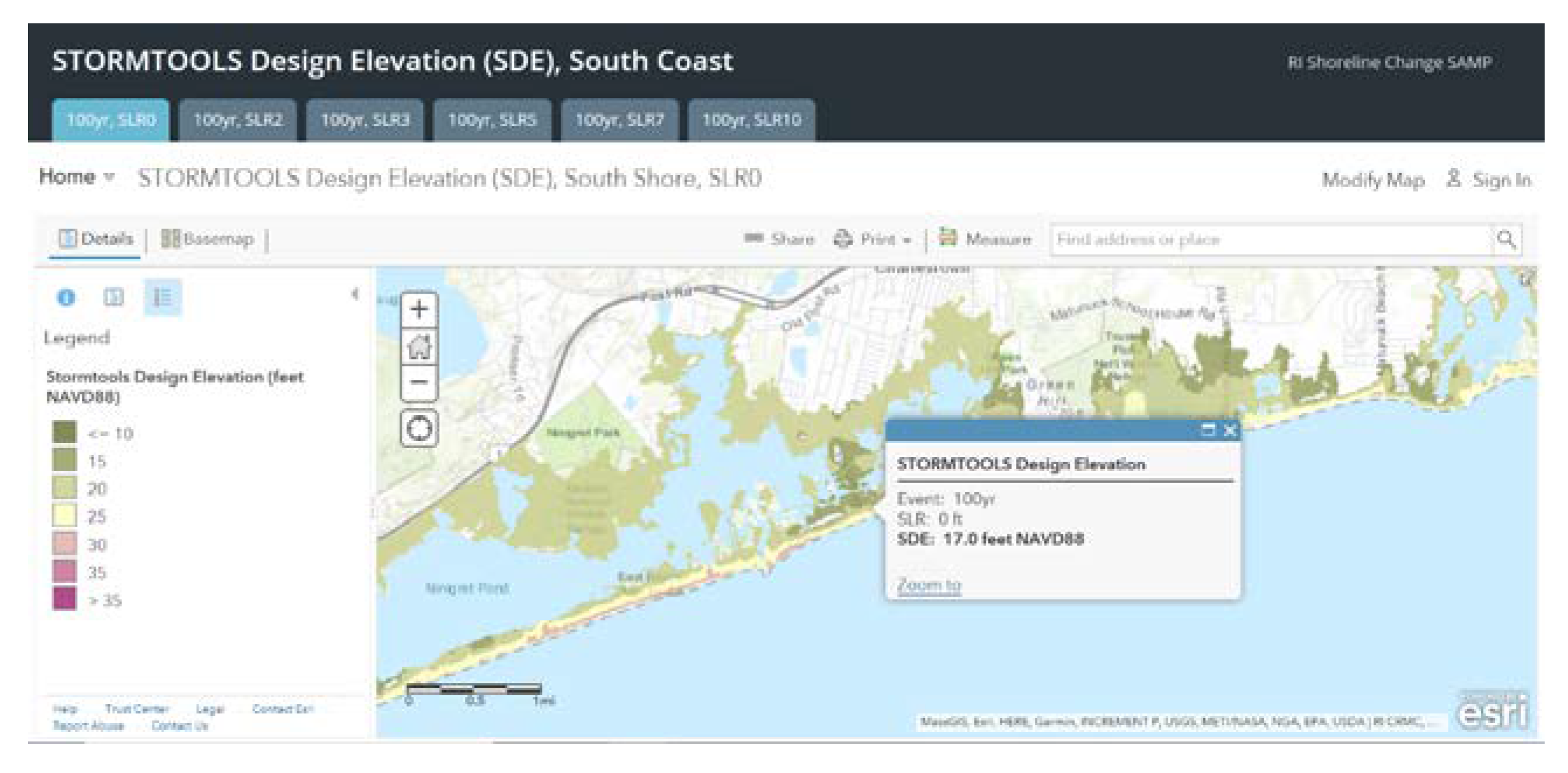
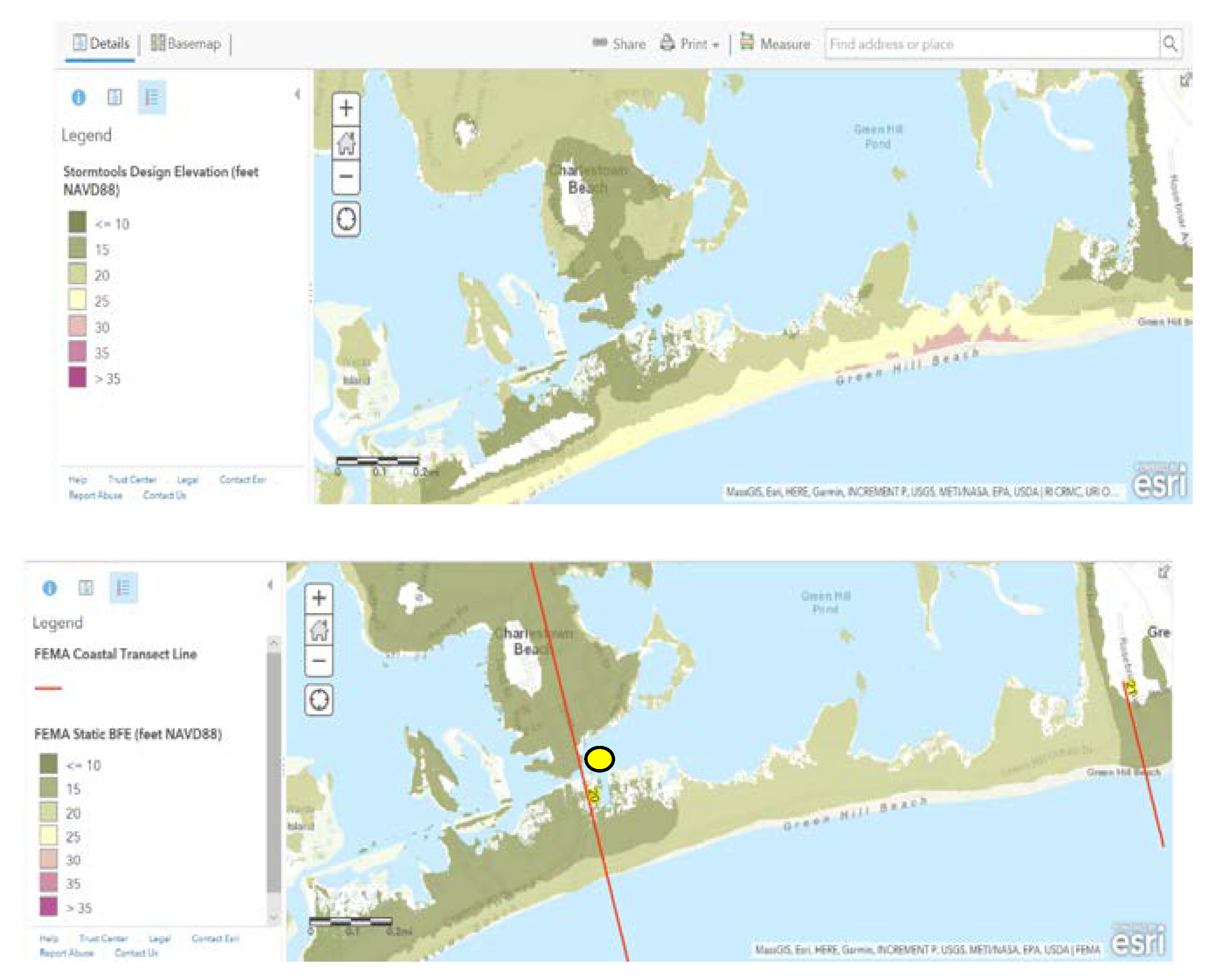
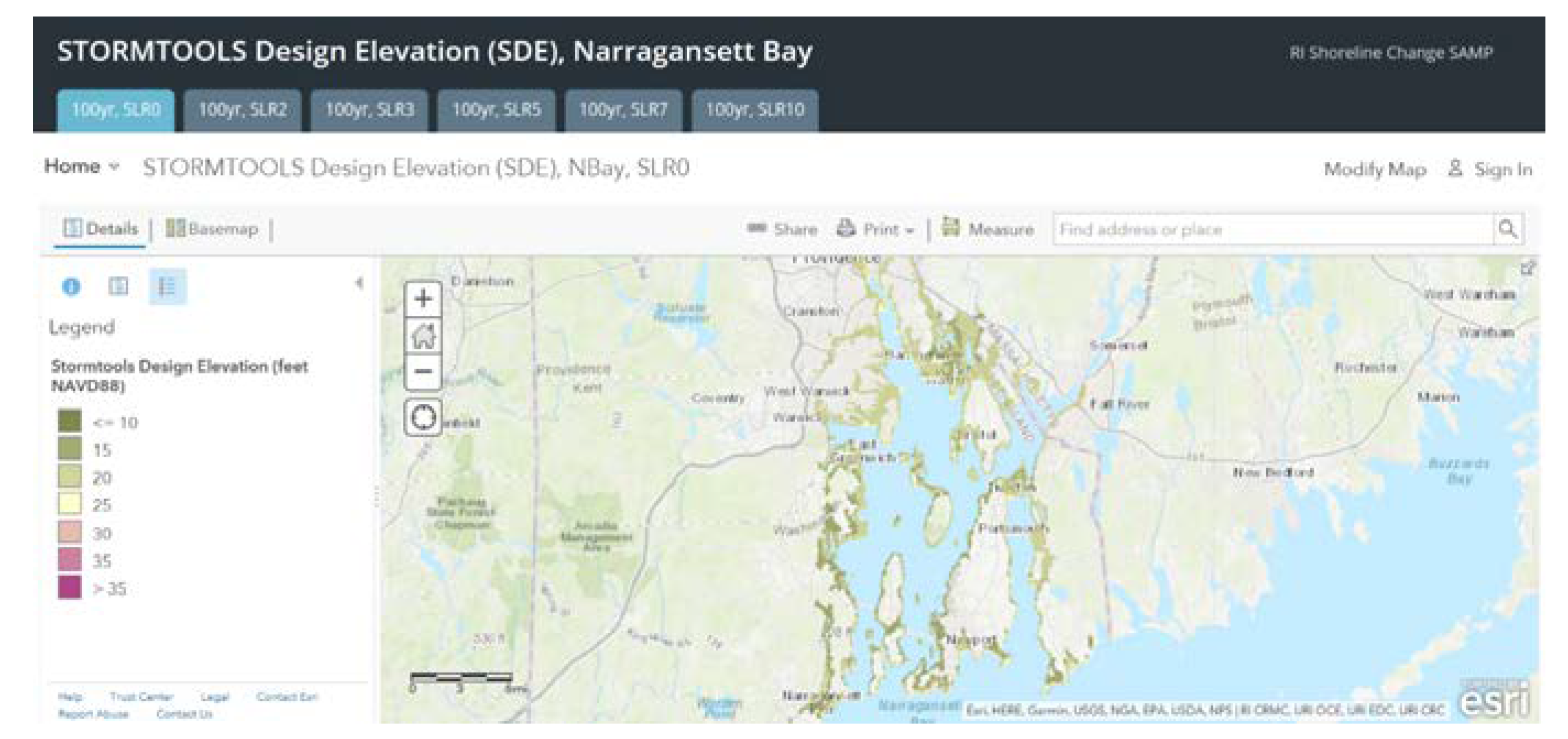
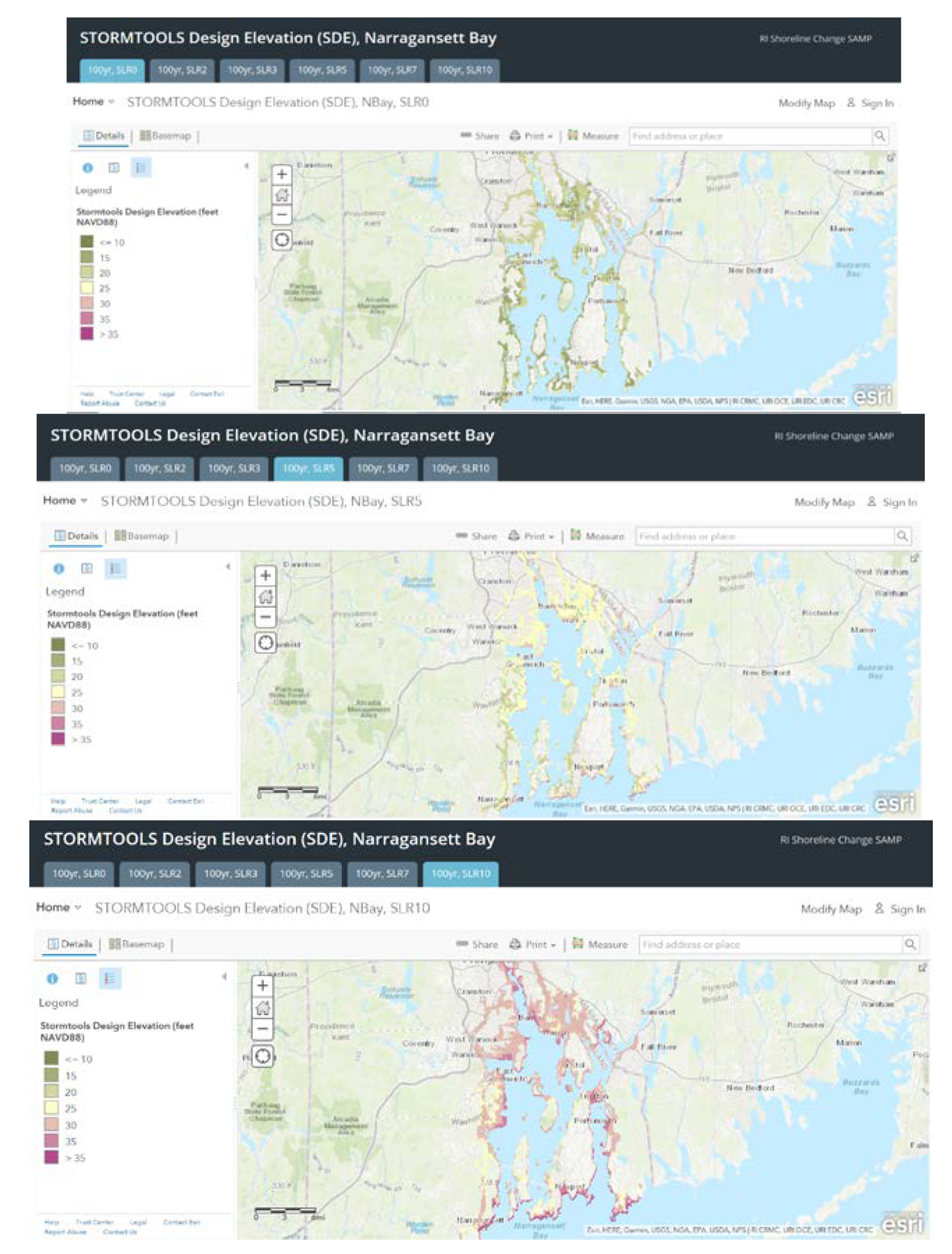
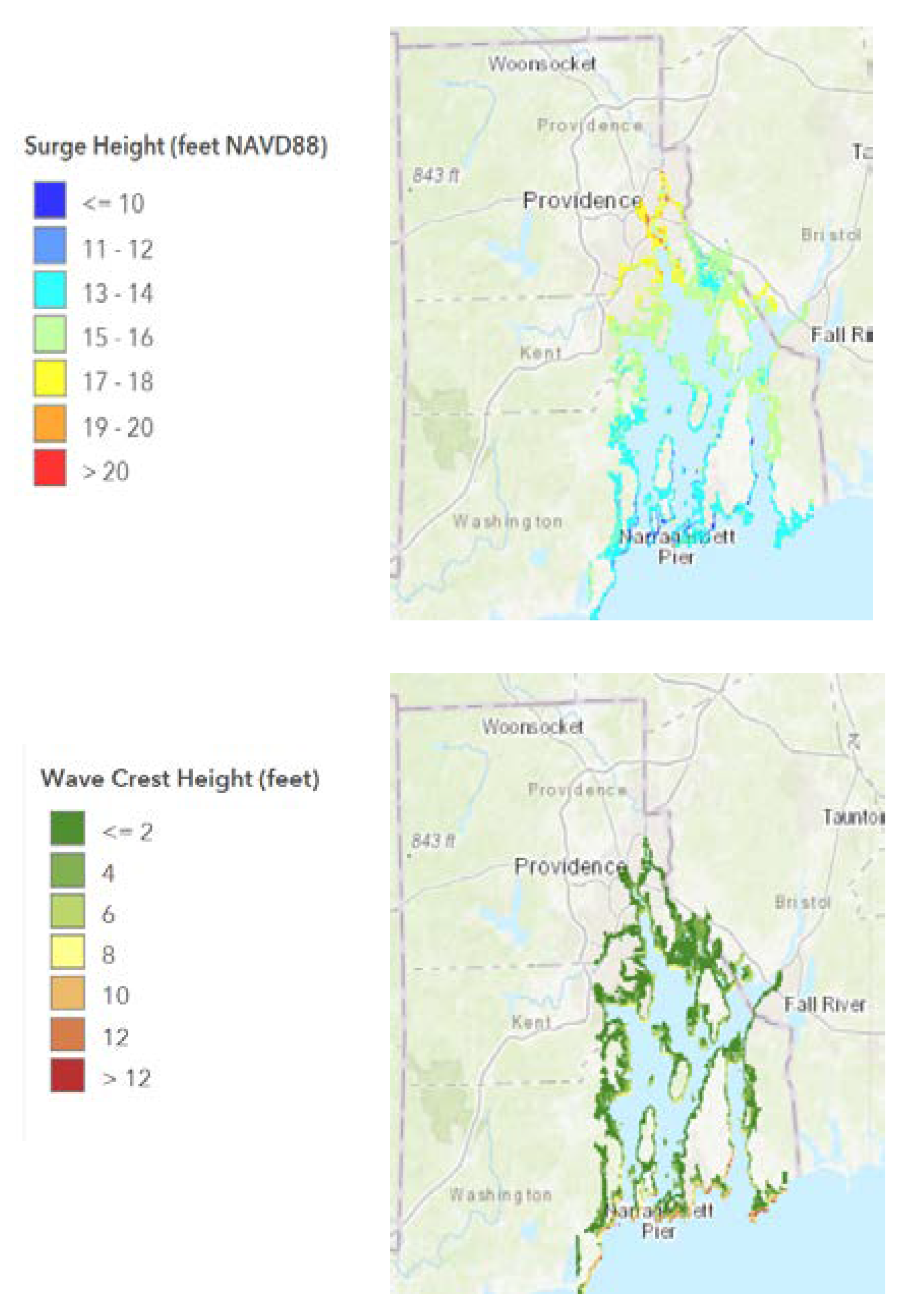
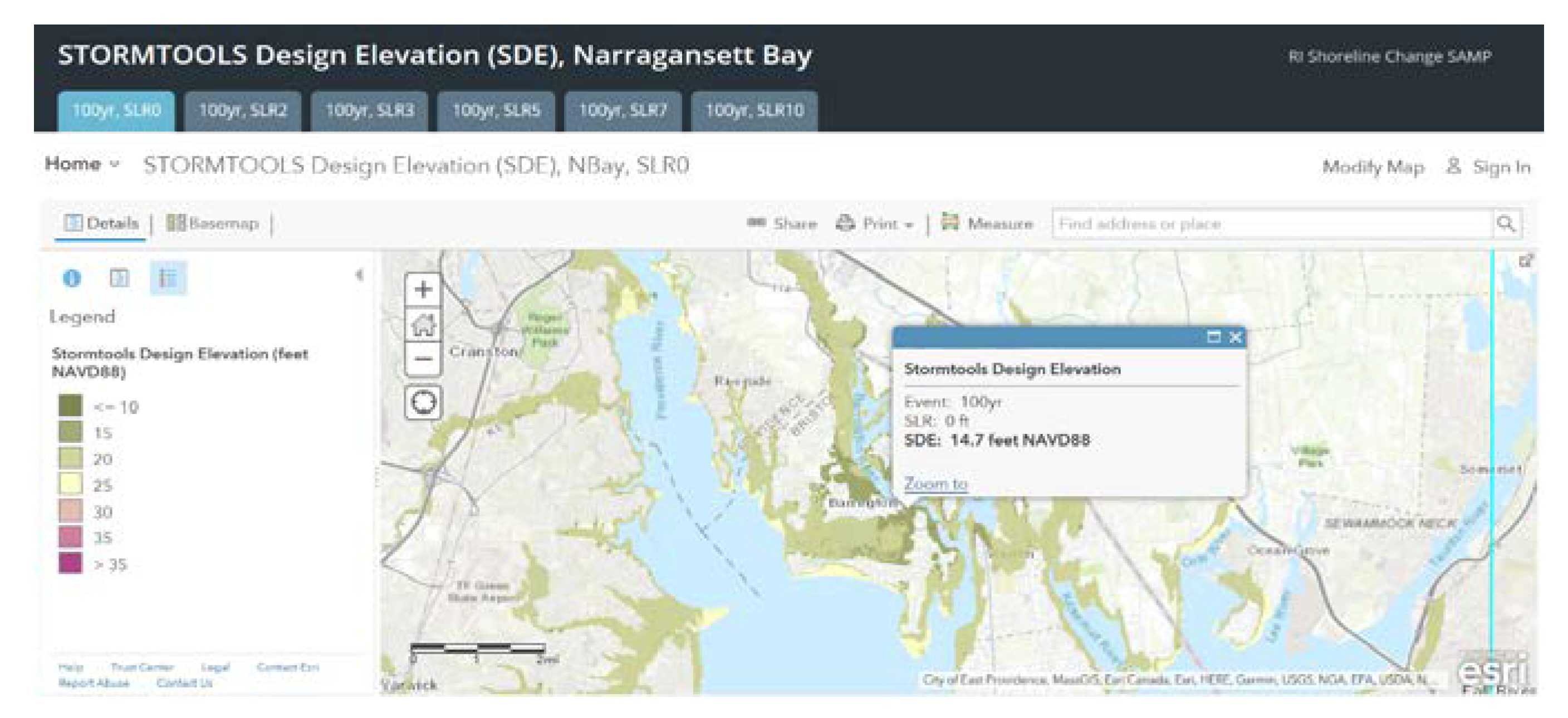
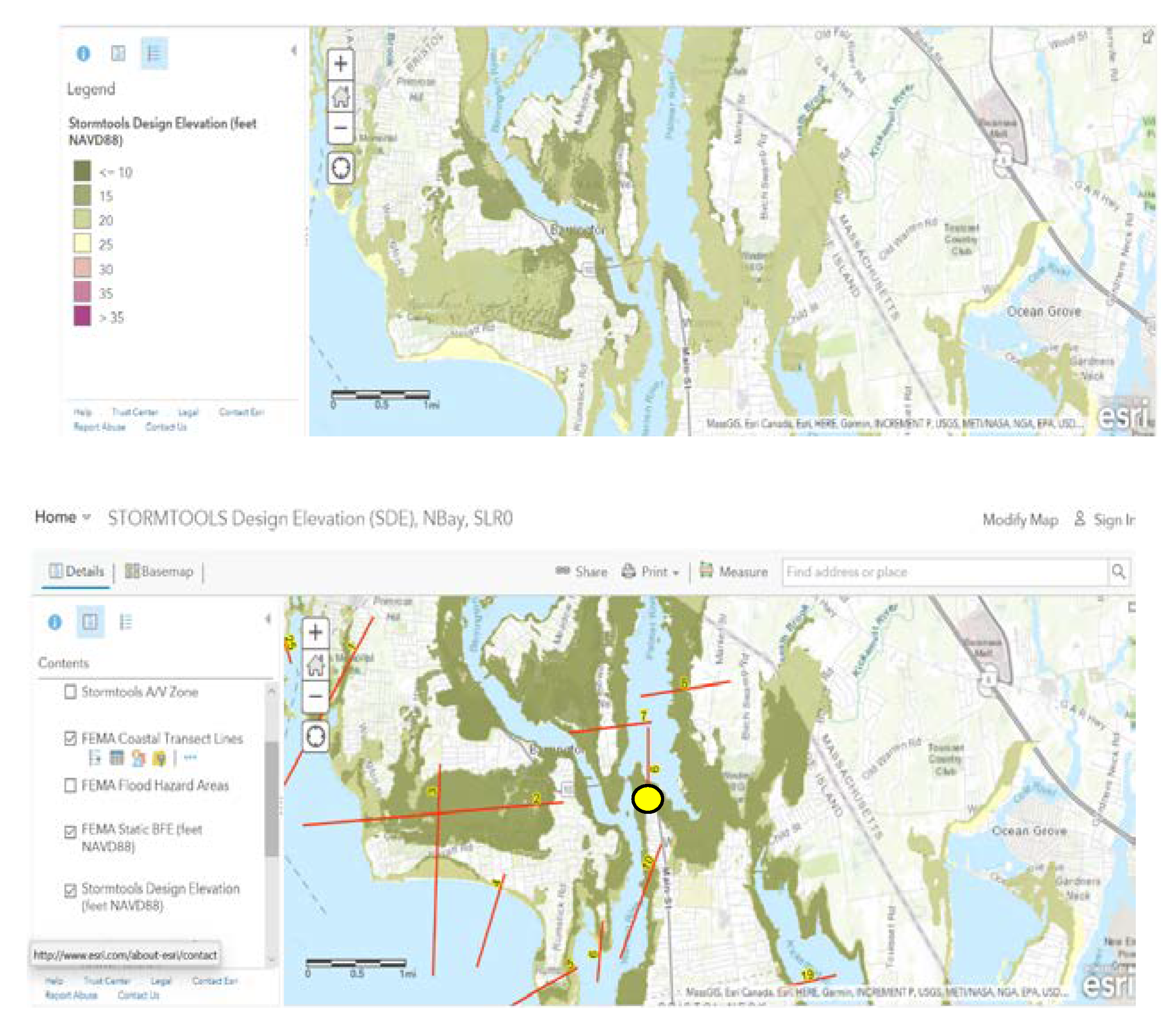
| Max Water Elevation (m) | ||||
|---|---|---|---|---|
| NACCS at Save Point 8741/10395 | ADCIRC-SWAN w/o SLR | ADCIRC_SWAN + 2m SLR | ADCIRC_SWAN Non-Linear with 2m SLR | |
| Newport | 3.43 | 3.38 | 5.38 | 5.21 |
| Providence | 5.46 | 5.48 | 7.48 | 7.05 |
| Location: | Rte 103 Bridge | Charlestown Breachway Bridge | ||||||
|---|---|---|---|---|---|---|---|---|
| Warren, RI | Charlestown, RI | |||||||
| Surge* | Wave | BFE* | BFE* | Surge* | Wave | BFE* | BFE* | |
| (ft) | Height | (ft) | (m) | (ft) | Height | (ft) | (m) | |
| (ft) | (ft) | |||||||
| FEMA FIRM | 12 | 3.66 | 14 | 4.27 | ||||
| SDE 0 SLR | 14.3 | 1.6 | 15.9 | 4.85 | 13.4 | 0.6 | 14.0 | 4.27 |
| SDE 2 SLR | 16.5 | 1.8 | 18.3 | 5.58 | 15.5 | 1.7 | 17.2 | 5.24 |
| SDE 3 SLR | 17.7 | 1.2 | 18.9 | 5.76 | 16.4 | 2.1 | 18.5 | 5.64 |
| SDE 5 SLR | 18.9 | 2.2 | 21.1 | 6.43 | 18.4 | 3.3 | 21.7 | 6.61 |
| SDE 7 SLR | 20.7 | 2.6 | 23.3 | 7.1 | 20.5 | 4.5 | 25.0 | 7.62 |
| SDE 10 SLR | 23.9 | 3.0 | 26.9 | 8.2 | 23.4 | 6.1 | 29.5 | 8.99 |
© 2020 by the authors. Licensee MDPI, Basel, Switzerland. This article is an open access article distributed under the terms and conditions of the Creative Commons Attribution (CC BY) license (http://creativecommons.org/licenses/by/4.0/).
Share and Cite
Spaulding, M.L.; Grilli, A.; Damon, C.; Hashemi, R.; Kouhi, S.; Fugate, G. Stormtools Design Elevation (SDE) Maps: Including Impact of Sea Level Rise. J. Mar. Sci. Eng. 2020, 8, 292. https://doi.org/10.3390/jmse8040292
Spaulding ML, Grilli A, Damon C, Hashemi R, Kouhi S, Fugate G. Stormtools Design Elevation (SDE) Maps: Including Impact of Sea Level Rise. Journal of Marine Science and Engineering. 2020; 8(4):292. https://doi.org/10.3390/jmse8040292
Chicago/Turabian StyleSpaulding, Malcolm L., Annette Grilli, Chris Damon, Reza Hashemi, Soroush Kouhi, and Grover Fugate. 2020. "Stormtools Design Elevation (SDE) Maps: Including Impact of Sea Level Rise" Journal of Marine Science and Engineering 8, no. 4: 292. https://doi.org/10.3390/jmse8040292
APA StyleSpaulding, M. L., Grilli, A., Damon, C., Hashemi, R., Kouhi, S., & Fugate, G. (2020). Stormtools Design Elevation (SDE) Maps: Including Impact of Sea Level Rise. Journal of Marine Science and Engineering, 8(4), 292. https://doi.org/10.3390/jmse8040292






